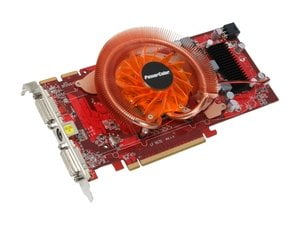
Beside the DisplayPort implementations, there also exists other display output layouts as dual DVI port or DVI with D-sub display output layout. The support for HDMI and D-sub ports is also achieved through separate dongles.
#Amd radeon hd 3870 size series
The Radeon HD 3600 series was based on the codenamed RV635 GPU, packed 378 million transistors on 55 nm fabrication process, and had 128-bit memory bus width.
#Amd radeon hd 3870 size driver
ĪMD stated the possibility of supporting 4 Radeon HD 3870 X2 cards, allowing 8 GPUs to be used on several motherboards, including the MSI K9A2 Platinum and Intel D5400XS, because these motherboards have sufficient spaces between PCI-E slots for dual-slot cooler video cards, presumably as a combination of two separate hardware CrossFire setups with a software CrossFire setup bridging the two, but currently with no driver support. Starting with the Catalyst 8.3 drivers, Amd/Ati officially supports CrossFireX technology for the 3800 series, which means that up to four GPUs can be used in a pair of Radeon HD 3870 X2. This has no negative effect on performance. They communicate via a bidirectional bus that has 16 lines for a bandwidth of 2 x 4 Gb/s. The card only integrates a PCI Express 1.1 bridge to connect the two GPUs. Technically, this Radeon HD 3870 X2 can really be understood as a CrossFire of two HD 3870 on a single PCB. The processor achieved a peak single-precision floating point performance of 1.06 TFLOPS, being the world's first single-PCB graphics product breaking the 1 TFLOP mark. Radeon HD 3870 X2 (codenamed R680) was released on January 28, 2008, featuring 2 RV670 cores with a maximum of 1 GiB GDDR3 SDRAM, targeting the enthusiast market and replacing the Radeon HD 2900 XT. The Radeon HD 3690 was released early February 2008 for the Chinese market only. All other hardware specifications are retained.Ī further announcement was made that there would be a Radeon HD 3830 variant bearing the same features as Radeon HD 3690, but with a unique device ID that does not allow add-in card partners in China to re-enable the burnt-out portion of the GPU core for more memory bandwidth. The Radeon HD 3690, which was limited only to the Chinese market where it was named HD 3830, has the same core as the Radeon 3800 series but with only a 128-bit memory controller and 256 MiB of GDDR3 memory. The Radeon HD 38 became available mid-November 2007. The RV670 GPU is also the base of the FireStream 9170 stream processor, which uses the GPU to perform general purpose floating-point calculations which were done in the CPU previously. The Radeon HD 3800 series was based on the codenamed RV670 GPU, packed 666 million transistors on a 55 nm fabrication process and had a die size at 192 mm 2, with the same 64 shader clusters as the R600 core, but the memory bus width was reduced to 256 bits. If the suppositions are true, we might face yet another delay.Main article: Radeon R600 (HD 2xxx, HD 3xxx) Series Radeon HD 3800
#Amd radeon hd 3870 size full
When it gets on the latter, the air is already hot and cannot absorb all the residual heat, so it is likely that the second core won't be able to function at full capacity. The fan blows the air over the first RV670 graphics core, then the airflow "floods" the second GPU. Both of the cores are cooled with two heatsinks and a single cooling fan on top of them.


I have told you yesterday about the fact that the reference card is a dual-GPU version with two RV670 graphics cores. It would be just great if that was it, but I think there are some technical troubles that need adjusting before releasing it to the hungry pack of gamers. Moreover, some of the oveclocking junkies out there might wait for the GeForce 9800 Gx2. But, given the pretty significant price tag ($615.35), I strongly doubt that they will run out of stock anytime soon. The initial supposition is that the company wants to let the retail stores pile some serious quantities of video cards on their stock, in order not to run out of the precious Radeon HD 3870 X2. Earlier this month, AMD announced that the video card would be officially unveiled on January the 23rd, but the company pushed forward the official unveiling for January the 28th.

The bottom line is that the official release of the shiny Radeon HD 3870 X2 graphics card has been re-scheduled for January 28 (the initial launch date). Things got a little fishy at the manufacturer's headquarters and we got a nice delay, the Advanced Micro Devices style. Bad news for the hardware enthusiasts and for the drooling overclockers that kept counting for an early release of the fastest video card on Earth.


 0 kommentar(er)
0 kommentar(er)
